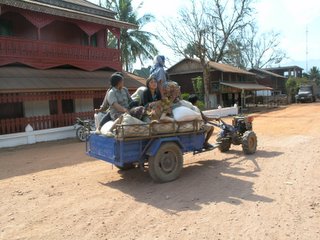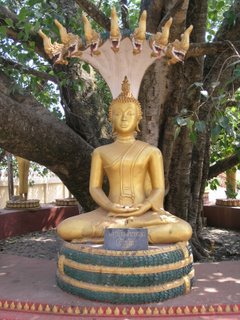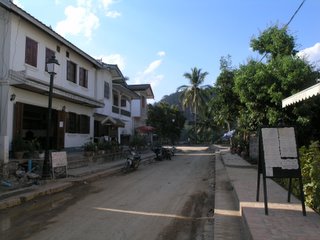
Monday, February 27, 2006
Lazy days and overcrowded buses

Saturday, February 25, 2006
Drug deals, dirt roads and pagodas

Friday, February 24, 2006
Trek to the Sida and Lenten tribes

Luang Nam Tha
Luang Nam Tha is a mountainous province which is home to 39 different ethnic minorities. It is also home to the Nam Ha National protected area (NPA), a 2224sq.km area of dense evergreen and semi-evergreen submontane forests, which is home to many species of animals and birds. 22% of the province's population are Buddhists, with the majority of the population practising various forms of ancestor and spirit worship. Luang Nam Tha itself is a major trading centre for commerce between China, Thailand and Laos.
Today got off to a bit of a bad start : i arrived at the Green Discovery office to pay the remaining balance on my trek and the price had gone up overnight from $18 to $24. Obviously i disputed the difference, and was informed that $18 is the price if there are 4 or more people participating and there are only 3. I pointed out that i wasn't disputing whether or not $24 was the correct price, but that the price i was quoted was $18 and i should not have to pay for the salesperson's mistake in quoting the wrong price to me. Maybe it's years of working in sales and customer service that makes me more intolerable to bad customer service, but as a salesperson, you cannot quote a price to someone, make a sale based on that price and then put the price up and expect your customer to be happy with it! I even offered to meet the guy half way and pay $21 (which is what he should have done for me at the very least) but he wouldn't budge. I had to pay an extra $6 or lose $10 (which was the deposit i'd paid). So reluctantly i paid the extra.
The other 2 people on my trek were a young couple, Andy and Kylie from Sunderland (just in the UK!), who'd been travelling since December the 2nd and had already passed through Malaysia, thailand, Cambodia, Vietnam, and China before arriving in Laos. After travelling Asia, they're off to Australia on a 12 month working visa, and this is all part of a 'career break' with Barclays Bank! The lucky b*****ds are still getting paid bonuses and they left their jobs in October!
There was a lot more walking involved in today's trek, the majority through a jungle environment, with the cover of a variety of lush green plants and trees. We crossed several streams, one of which i managed to fall into when i lost my footing on the makeshift bridge! After about 3 hours of moderately tough walking, we stopped for lunch by the side of a small pathway leading to the Sida village which we would visit afterwards. Our guide Si laid out some banana leaves to use as a table and chairs and we shared a meal very similar to yesterday's : sticky rice and accompanying sauces and dips.
At the village we were allowed to walk around for a short time, the three of us all captivated by the sight of several recently new born puppies struggling to walk very steadily on their tiny paws. However the majority of our 1-2 hour visit was spent sat up at the school. Our guide did encourage us to ask questions but i would have preferred a more thorough tour of the village and some time to simply witness these people interacting with each other in their natural environment. For about half an hour our guide was actually asleep in the sun whilst Andy, Kylie and i discussd the concept of drinking snake blood and eating your dog!
The last 2 hours of the trek were mostly downhill and finished up at the Lenten village of Ban Nam Di, 6km north east of Luang Nam Tha. The villagers practice the art of bamboo papermaking. They turn bamboo into pulp along the banks of the Nam Di adjacent to the village, and then spread the pulp into thin sheets over square cotton screens to produce a rustic papaer on which they record religious literature. The paper is also used extensively in the handicraft industry.
I did enjoy the trek but our guide, conscientious as he was for the most part, had only worked for Green Discovery for 3 months - and it showed. We arrived back in Luang Nam Tha at around 4pm so i spent a couple of hours sat outside in the sun at KMT (handicraft shop/internet cafe/eating establishment) drinking Lao coffee and watching the world go by.
Photo is of a basket weaver at the Sida village, Near Luang Nam Tha
Thursday, February 23, 2006
The Akha experience

Wednesday, February 22, 2006
The long journey from Vang Vieng to Muang Sing

The bus journey was by mini bus (as it appears that public buses do not run the Vang Vieng - Luang Prabang route) so $8 and 7 hours later i was back in Lunag Prabang - for the third time! I was not really in the mood for socialising this evening but the Japanese guy, Endi, who i was talking to when we stopped for lunch, decided to jump into the same tuk tuk as me, check into the same guesthouse and then ask me out to dinner. As i was only in Luang Prabang for one night, it seemed rude to refuse. So we ate at a restaurant right opposite the bakery on Sisavangvong Road, with the bubbliest, dizziest, and most enthusiastic waitress i've had the pleasure of encountering.
Luang Prabang - Udomaxi - Luang Nam Tha
I shared my breakfast table this morning with the tiniest little kitten. He hopped up on to my lap, paws on the table, peered over my bowl of noodle soup and stayed there until the cafe owner spotted him, picked him up by the scruff of his neck and deposited him rather carelessly into a back room.
When i got to the bus station, it soon became apparent that there was no bus directly to Luang Nam Tha from Luang Prabang : it involved a change at Udomaxi. Due to getting off the bus at the 1st toilet stop, i lost my seat and had the pleasure of being stuck on a small plastic stool in the aisle for the remainder of the 5 hour journey.
This was followed by a 2 hour wait at Udomaxi and another 4 hour bus journey to Luang Nam Tha (total cost 63,000KIP), which meant arriving at our destination at 8pm. Luang Nam Tha is not very well lit at night so i chaecked into the first guesthouse i spotted, The Bus Station Guesthouse ($3.50 for bamboo hut with private bathroom). I managed to find somewhere to eat (The Panda Restaurant) but the only internet cafe i'd seen on my way in had shut down by 9pm - as had most of the town.
Luang Nam Tha - Muang Sing
Had a bit of a wander around Luang Nam Tha's Morning Market before catching the Songthaew (17,000KIP, 1.5hrs) to Muang Sing. I checked into the Thi-Lu Guesthouse for $2 per night (not quite as cheap as sharing with James in Muang Ngoi but for the equivalent of 1.12 i have my own private bathroom, albeit with a very cold shower!) and then sampled their restaurant food for lunch. I had Mak Kaew, which is a local peppery chilli paste with vegetables for dipping and sticky rice. It's the only restaurant in Muang Sing that serves this dish (apparently) and i shall be asking whether i can buy some to take with me!
Muang Sing
Muang Sing sits on the river plains of the Mam La, 10km from the Chinese border. Muang Sing is a traditional Thai Lu and Thai Neua cultural nexus as well as a trade centre for Thai Dam, Akha, Hmong, Mien, Lolo and Yunnanese. The town itself is dominated by Thai-Lu (30% of total) and the surrounding hills by Akha (45% of total).
This afternoon i did a walking tour of the town, a town which i expected to be over-run with tourists due to the fact that it seems to be earning a reputation among travelers as THE place to go trekking in Laos. However once you leave the main street, Muang Sing is incredibly rural : little bamboo huts with thatched roofs, women washing their hair in the street with a huge wooden bucket of water, little children staring at you like they've never seen another foreigner before, and the older ones approaching you to practice their English and wanting to know everything about you. There wasn't another tourist in sight until i reached the Muang Sing Tourist Information & Trekking Guide Service Centre.
I had planned to do a 2 day trek here but the agency, in a bid to protect the environment and control the impact of toursim on the local villages, will not run treks AT ALL unless the appropriate number of people show an interest. Even then, they will only run treks to certain areas on certain days. No-one had shown an interest in a 2 day trek for tomorrow and in keeping with the eco-tourism bid, there was only one 1 day trek on offer.
Whilst enquiring about the trek, i got chatting to an Australian lady, Joy (who i'd imagine was a bit of a hippy in her day) who was also interested in the same trek. For $10 we both decided to go ahead and book it, went for coffee together afterwards (oh how i love Lao coffee!) and i joined her for dinner later at the Viengxay Restaurant.
Photo is of a typical street scene in Muang Sing.
Sunday, February 19, 2006
Tubing down the Nam Song

Saturday, February 18, 2006
Arrival in Vang Vieng

Friday, February 17, 2006
10 hours on a bus to the 'Sandlewood City'

- You always have a huge wad of money with you, even if you're only carrying 10 pounds
- Due to the fact that you always have a huge wad of money with you, it gives you the misleading impression that you actually have lots of money, when really you only have 10 pounds!
Eureka!
Wednesday, February 15, 2006
Sunsets and goodbyes

Initially when i planned to enter Laos (before the prospect of meeting up with James arose) i had planned to head up to Luang Nam Tha and Muang Sing from Huay Xai and then back down to Lunag Prabang (via Udomaxi) and on through to Vang Vieng and Vientiane. Due to having to pay the majority of my speedboat fee in dollars and making the diversion to Nong Khiaw and Muang Ngoi, i now do not have enough money or time to complete the loop up to Luang Nam Tha and Muang Sing AND get down to Vientiane. Wiring money is expensive (about 60 quid)and takes time, so my only option is to take a detour straight down to Vientiane when James leaves.
We spent the evening firstly down at a little restaurant right on the beach (which James had spotted on the boat out to Nong Khiaw) to watch the sunset, and then headed up to Lao Lao Garden (right next to the popular Westerner's hangout, The Hive Bar) warming ourselves around a huge camp fire, which was the focal point of the pretty outside seating area.
Monday, February 13, 2006
Row row row your boat (no so) gently down the stream!

Final thoughts on Nong Khiaw and Muang Ngoi Nong Khiaw is a stunning place but Muang Ngoi feels like a slightly truer slice of Lao village life. Although it attracts slightly more tourists than Nong Khiaw, this does not detract at all from the beauty and authenticity of this sleepy little village tucked away in the mountains.
|
Sunday, February 12, 2006
Fishing voyage up the Nam Ou

Saturday, February 11, 2006
Cave swimming at Muang Ngoi

Friday, February 10, 2006
Riding the Mekong and Nam Ou rivers to Nong Khiaw

- Boats leave daily at 9am
- Cost from $9 - $12 depending on which travel agent you buy your ticket from
- Journey takes approximately 7hrs
- Boat makes only 1 'toilet stop' on a deserted beach so be prepared for the lack of privacy!
- There are no stops for food (unless you count a couple of handfuls of the driver's sticky rice!) or drink so bring your own
When we arrived at Nong Khiaw we were blown away and definitely agreed we'd made the right decision on our chosen destination : brightly painted paddle boats rocking gently on the calm blue water, which glistened in the sun. Bamboo huts nestled high up on the banks of the river and towering mountains rising up behind them, the tops of the mountains disappearing into the clouds scattered across the sky.
We searched out Bamboo Paradise Guesthouse on a recommendation from a Dutch guy we spoke to when we arrived. $4 per night bought us our own little bamboo hut with balcony (and 2 little wicker chairs) overlooking the imposing stone bridge which linked the two sides of the village across the Nam ou river. It had a pretty garden decorated with (amongst other things) dismantled bombs and strange little straw figures hanging from the trees!
Electricity was very limited in Nong Khiaw so most of our evening was spent by candlelight at the Sunset Restaurant. It was the first place in Laos that i'd seen river moss (a Lao speciality) on the menu so we decided to be brave and give our tastebuds a treat. We were not disappointed : it's dried, cooked in oil and garlic and coated in sesame seeds, and tastes delicious.
Lao food is a lot less spicy than Thai food, so even if you ask for it "very very spicy" (as James does), it isn't going to blow the roof of your mouth off by any stretch of the imagination. It's also a lot easier to get vegetarian food here than i'd imagined. Almost every menu i've seen has a vegetarian or "Vegetable" section.
Photo is of some of the Lao children who greeted us on the boat journey to Nong Khiaw
Thursday, February 09, 2006
Lazy days in Luang Prabang

Luang Prabang
Luang Prabang is a town encircled by mountains and set 700m above sea level at the confluence of the Nam Khan and the Mekong river. Luang Prabang's streets are lined with crumbling French colonial architecture, towering coconut palms, and orange-wrapped Buddhist monks who still occupy 32 of the original 66 historic temples built before the era of French colonisation.
James and i started the day with a Canadian style breakfast : strong Lao coffee (Nam Nom) and a large chocolate donut to share, before climbing the steps up to the 100m high Mount Phu Si. 24m high That Chomsi (erected 1804) sits at the summit but what you really make the climb for is the spectacular view across Luang Prabang and the Khan and Mekong rivers. We picked a lovely time of day to make the climb : just as the morning mist had lifted to reveal a perfectly clear blue sky.
On the descent from the summit is the site of a holy Boddhi tree, where we felt like very foolish tourists scouring the ground for a perfect heart-shaped Boddhi leaf. Apparently they're quite a valuable item to own here in Laos!
Our afternoon was spent wandering around the handicraft markets and debating whether to take the "tuk tuk waterfall" being offered to us at every corner. Ultimately we decided that the number of tuk tuk drivers offering the ride up to the waterfall must either mean it's swarming with tourists or not very impressive and therefore not worth the $15 journey up there. Alternatively, maybe we're just drifting into the laid back Lao way of life . . .
As the sun went down the streets of Sisavangvong road were lined with hundreds of food and handicraft stalls which formed part of Luang Prabang's night market. It's one of the better night markets i've seen, and if you want to buy one of the hand woven silk scarves or shawls or skirts (actually made in Luang Prabang itself) then you'll get the best price at the night market. James looked like he was finally having fun with the whole bartering idea! The night market is also a great place to eat : Vegetarian or Vegan buffets for 5,000KIP (approximately 25p). However, as James likes his meat we went back to Tom Tom Bamboo for the biggest meal i've eaten throughout my entire trip : fresh spring rolls with vegetables and sweet chilli sauce & deep fried cuttle fish, and those were just the starters! Good job James was paying!
Wednesday, February 08, 2006
Mission nearly-impossible!
